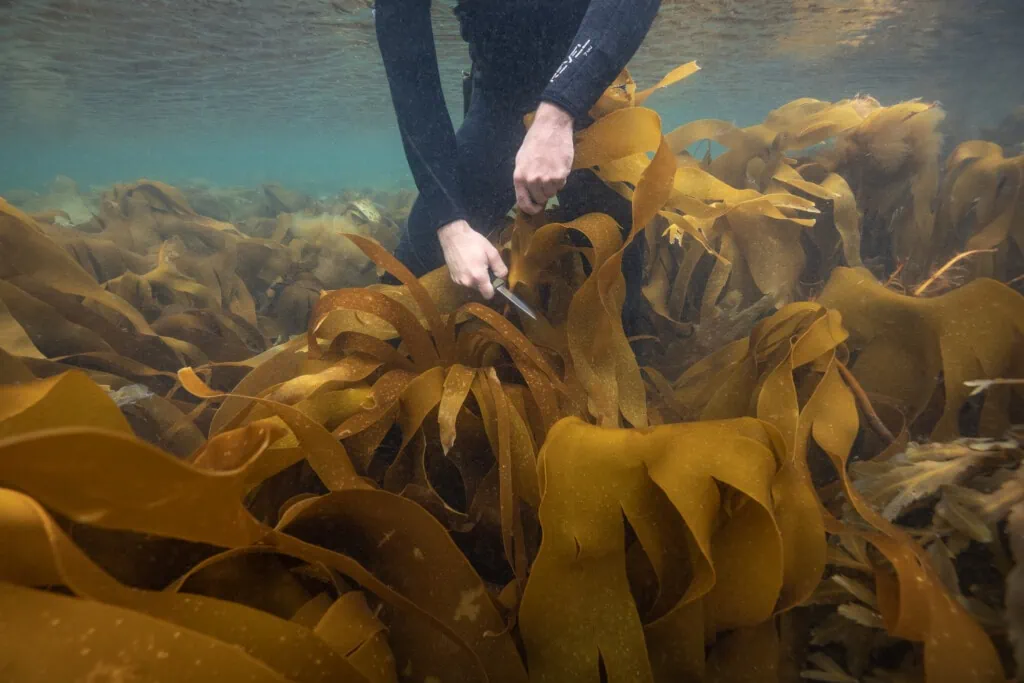Seaweed vs Kelp: What Is The Difference?
Seaweed and kelp are terms that are often used interchangeably, but there is a distinction between them. Both are forms of marine algae, but they differ mainly in their biological classification and ecological roles. Read on for a breakdown of the main differences between seaweed vs kelp.
Table of Contents

Seaweed
“Seaweed” is a general term that encompasses many different species of marine plants and algae that grow in saltwater and sometimes in freshwater. Seaweeds belong to several different groups based on their pigmentation, structure, and other characteristics. These groups include:
- Red algae (Rhodophyta): Often found at greater depths due to their ability to absorb blue light and penetrate deeper into the water.
- Green algae (Chlorophyta): Similar to land plants in many ways, they are found in both marine and freshwater environments.
- Brown algae (Phaeophyceae): Typically found in colder waters along rocky coasts and includes many seaweed species used in cooking and industry.
Seaweeds come in various sizes, from tiny, almost microscopic species to larger ones that can extend several meters in length.
Kelp
Kelp specifically refers to a subgroup of large brown algae, all belonging to the order Laminariales. This group includes some of the largest seaweeds in the world. Kelp is known for forming dense underwater forests that are rich in biodiversity and serve as important habitats for marine life. Unlike other types of seaweed, kelp requires nutrient-rich waters with cooler temperatures and typically attaches itself to rocky substrates through a holdfast—a root-like structure.
Key Differences
- Size and Complexity: Kelp is generally larger and more structurally complex than most other types of seaweed. It has a defined structure with a holdfast, a stipe (similar to a stem), and blades (leaf-like structures).
- Ecological Role: Kelp forests are crucial marine environments that provide shelter and food for diverse marine species. While other seaweeds also play significant ecological roles, kelp forests are particularly known for their ability to support large ecosystems.
- Habitat: Kelp is mostly found in colder, nutrient-rich waters, while other types of seaweed can be found in a broader range of environments, including warmer waters and in both the ocean and freshwater sources.
Both kelp and other forms of seaweed are valuable for their ecological roles and their uses in human activities such as food, supplements, and various industrial applications. However, kelp is particularly noted for its ecological importance and its unique adaptations to life in cold, nutrient-rich marine environments, in the form of mighty kelp forests.
Kelp forests
Ecological Importance
- Biodiversity: Kelp forests are among the most vibrant underwater ecosystems, providing habitat, food, and nursery grounds for a variety of marine organisms, including fish, invertebrates, and marine mammals. This biodiversity is crucial for maintaining the health and balance of marine ecosystems.
- Productivity: Kelp is extremely fast-growing and supports a wide range of marine life with its productivity. The biomass produced by kelp forests is a vital component of the food web, sustaining many marine species from small invertebrates to large fish.
Environmental Benefits
- Carbon Sequestration: Kelp forests play a significant role in carbon cycling. Through photosynthesis, kelp absorbs carbon dioxide from the atmosphere, helping to mitigate the effects of climate change. This carbon is either sequestered in the deep sea as kelp detritus sinks or transferred through the marine food chain.
- Coastal Protection: The physical structure of kelp forests helps dampen wave action and protects coastlines from erosion. This buffering capacity is increasingly important as storm intensity and sea levels rise due to climate change.
- Water Quality: By absorbing nutrients and particulates from the water, kelp helps improve water clarity and quality. This filtration process is crucial in nutrient-rich waters where excess nutrients can lead to harmful algal blooms.
Economic Value
- Fisheries: Many commercially important fish species rely on kelp forests for part of their life cycle. These ecosystems support a robust recreational and commercial fishing industry, which is vital for the economies of many coastal communities.
- Tourism and Recreation: The unique beauty and biodiversity of kelp forests make them popular destinations for divers, snorkelers, and eco-tourists, providing economic benefits through tourism.
Climate Resilience
- Adaptation to Climate Change: Kelp forests are increasingly recognized for their potential role in climate adaptation strategies. By buffering coastlines and providing alternative food sources and habitats, they can help marine and human communities adapt to the changing climate.
Kelp forests are thus critical not only for their immediate marine environment but also for their broader contributions to global ecological health, climate regulation, and economic stability. Protecting and restoring kelp forests is essential to sustain these benefits.